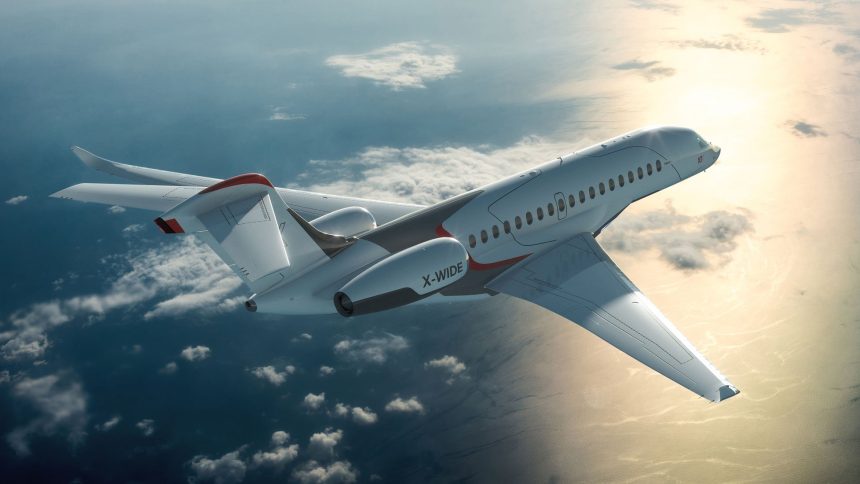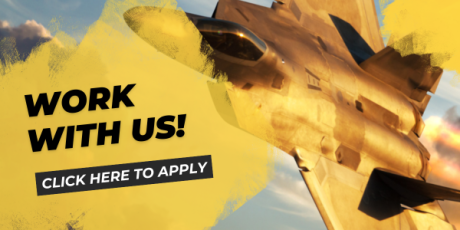As France leans towards Saab’s GlobalEye, based on Bombardier’s Global 6000, Dassault Aviation chief Éric Trappier manifested “displeasure” for the Falcon 10X’s exclusion.
Since last year, it has been reported that France is considering Saab’s GlobalEye AEW&C (Airborne Warning and Control) system to replace its four older E-3F Sentry AWACS (Airborne Early Warning and Control) aircraft. According to Opex360, the domestic option of Dassault Aviation’s Falcon 10X was also mentioned in a recent hearing before the country’s lawmakers in the National Assembly, where Dassault Aviation chief Éric Trappier expressed his displeasure about the possible selection of a foreign system.
Reports about France considering the GlobalEye AEW&C appeared multiple times in 2024, with the issue believed to have been discussed during French President Emmanuel Macron’s Jan. 2024 visit to Sweden. Intelligence Online reported in July 2024 about Paris having “finalized” a deal with Stockholm, but so far no formal announcement has been made in this regard.
These reports also followed the visit of a GlobalEye in France in April 2024, flying for five days from Mont-de-Marsan Air Base (BA118). The base is home of the Centre d’Expertise Aérienne Militaire (CEAM), which develops and tests new and/or upgraded systems for the French Air and Space Force.
In January 2024, the French newspaper Les Échos also suggested that the Falcon 10X satisfied all the requirements for the E-3F’s replacement, implementing the GlobalEye system as a “long-term project to Europeanize a major air defense system.” Dassault highlighted the benefits to the domestic ecosystem from its investments in the Mérignac region for the aircraft’s production.
The Dassault Falcon 10X was also in the running for the country’s next MPA (Maritime Patrol Aircraft) to replace its older 1960s era Bréguet Atlantique 2. Paris now appears to lean towards the Airbus A321, after the French Defense Procurement Agency signed a contract with the firm for a risk reduction study to ease the transition between the concept and production phase.

Saab GlobalEye and Dassault Falcon 10X
Saab’s S 106 GlobalEye AEW&C aircraft is derived from the company’s Erieye airborne radar system carried on the Saab 340 AEW, Saab 2000 AEW, and Embraer E-99 aerial platforms. In the case of GlobalEye, Erieye is installed on the Canadian-made Bombardier Global 6000/6500 aircraft family, Saab says.
The Erieye radar system, based around the PS-890 AESA (Active Electronically Scanned Array) radar, is mounted in a distinctive ‘plank’ above the carrier aircraft’s fuselage. According to Jane’s, it enables a detection range of up to 450 km for fighter-sized aircraft, depending on altitude and the radar cross section.
Along with AEW&C capability, the upgraded Erieye ER system offers maritime surveillance with a Leonardo SeaSpray 7500E radar, assisted by a FLIR Systems Star Safire 380-HD EO/IR turret. It also has a GMTI (Ground Moving Target Indication) capability.
The system is already in use with Sweden and the UAE (United Arab Emirates) with two and five active units, respectively. The combined Saab GlobalEye-Bombardier Global 6000 platform made its first test flight in March 2018, collecting extensive data in a one hour 46 minute trial.
France wants to turn to the Swedish @Saab GlobalEye to replace its Awacs planeshttps://t.co/HH3WuPBH7f pic.twitter.com/pk6iatwn51
— Fly High Aeromedia (@FHAeromedia) January 30, 2024
Meanwhile, Dassault Aviation’s first Falcon 10X ultra-long range business jet is in the final assembly stage at the company’s Bordeaux-Mérignac facility, with AINOnline reporting on Apr. 8, 2025 that the firm is looking at a late-2027 service entry. The company is also conducting airframe load and fatigue limit testing on a mechanical testbed, while in late 2024 Rolls-Royce concluded the flight-test campaign for the Falcon 10X’s Pearl 10X engine, the report added.
That report also came a day before chairman and CEO of Dassault Aviation Eric Trappier appeared before the National Defense and Armed Forces Committee on Apr. 9. According to the Opex360 report, he “lamented” the choice of the Canadian aircraft to carry the Erieye ER system as part of the GlobalEye AEW&C system.
“It would still bother me if my Canadian competitor, even though I have a lot of respect for my competitors, entered the defense sector. It would bother me if Saab, which is not a particularly French company but which I like, came to do work on a Bombardier. I think it would be much smarter to have the people who already work on the Falcons in the Aquitaine region and elsewhere work there rather than working on a Canadian aircraft,” said Trappier to the parliamentary panel.
#DassaultAviation lance le #Falcon 10X, le plus avancé et le plus spacieux des avions d’affaires https://t.co/ZzCDu4ibz0
Dassault Aviation Launches #Falcon10X, featuring Industry’s Largest Cabin and Most Advanced Technology on a Business Jet https://t.co/rvq5Zvrtvq pic.twitter.com/HqhYbwtiPd
— Dassault Aviation (@Dassault_OnAir) May 6, 2021
E-3F Sentry AWACS modernization
The French Air and Space Force (Armée de l’Air et de l’Espace) currently operates four E-3F Sentry AWACS aircraft, first delivered in the early 1990s. The F variant has French-specific modifications and flies with the CM56-2 turbofan engines built by France’s Safran.
One of the E-3Fs, assigned to the 36th Airborne Detection and Control Squadron, was also tested with a Joint Range Extension (JRE) tactical communications suite on Mar. 18, 2025 by the CEAM (Military Air Expertise Center) at Kourou, in French Guyana.
🔧 En octobre 2023, la BA 702 d’Avord a réalisé une première en France : le démontage du radar primaire de l’E-3F Awacs. Soutenus par Air France et l’USAF, les mécaniciens de l’ESTA ont remplacé l’antenne fragile. L’E-3F a repris service dès décembre 2023. pic.twitter.com/HxoqkpjtUV
— Armée de l’Air et de l’Espace (@Armee_de_lair) May 20, 2024
The flight testing of the JRE validated its capability to allow “a tactical situation to be transmitted securely via a satellite link without range limitation.” The CEAM added that the JRE capability, combined with surveillance and detection resources, has “strengthened the control and security of operations,” marking a “strategic turning point in the use of surveillance aircraft.”
The E-3F’s existing wide range of communications capabilities allows it to transmit tactical situational information to ground command centers and friendly aircraft in flight, although its range is described as “short.”
French E-3F Awacs aerial refueling over Middle East
Based at Al Udeid Air Base #Qatar#France #FrAF #Chammal pic.twitter.com/eNOKJ3I2vY
— Tom Antonov (@Tom_Antonov) April 6, 2016
The fleet however continues to throw up problems, one in particular in Oct. 2023, when an E-3F AN/APY-2 primary radar was not functioning properly. The size and fragility of the rotodome and the radar array led the Aeronautical Technical Support Squadron of the 36th Airborne Command and Control Wing to use an ingenious solution to carry out repairs, using an inflatable cushion to support the structure, Opex360 reported.









